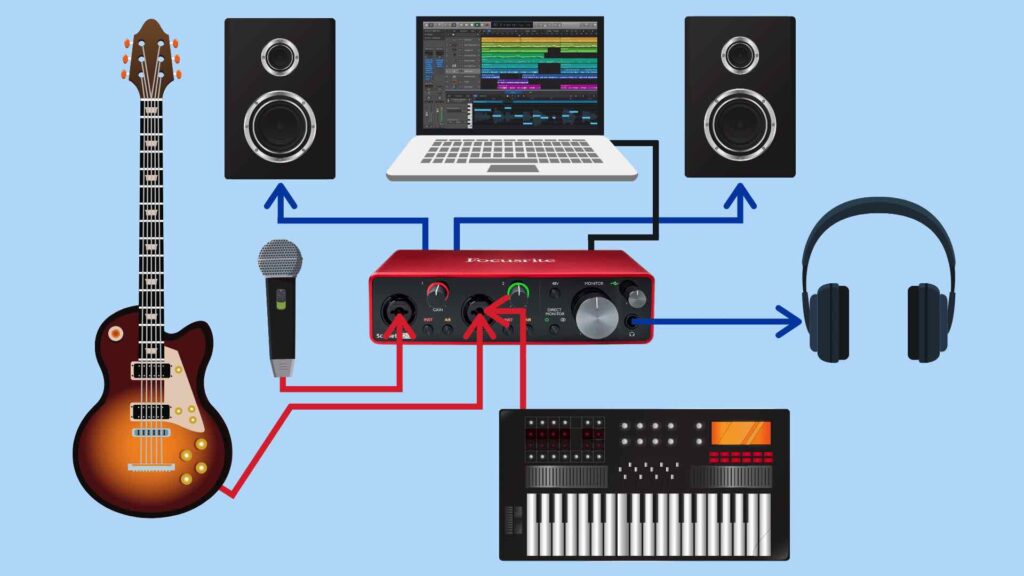
So, you’ve either bought an audio interface, or you’re thinking about buying one. Regardless, you have one question in mind. Is an audio interface a DAC? In this article I’ll answer your question and explain in detail what DAC is, why it’s needed, what an audio interface is, and help you to decide if you should buy and audio interface or a standalone DAC.
Is an Audio Interface a DAC?
Any audio interface has a DAC (Digital-to-Analag Converter) built within it. This is so it can convert a digital signal (like a wav file) into an analog one, like the sound you hear coming from your speaker. Without a DAC you wouldn’t be able to hear the audio that you’ve recorded. Audio interfaces also have ADCs (Analog-to-Digital Converters) in-built. This allows you to hear the audio that you record in the form of a digital audio file.
What is DAC?

DAC stands for Digital-to-Analog Conversion. Digital signals are those that contain data, usually in the form of binary (1s and 0s). An analog signal is continuous, time-varying and can be measured. For example, we measure electrical signals by voltage and sound signals by pressure.
In terms of audio, a digital-to-analog converter will convert a digital audio file (such as a wav or mp3) into an analog signal like one that comes out of your speaker or headphones. Basically, without a DAC, you wouldn’t be able to hear the music you create or play from your computer or car stereo, which would really suck, right?
Any device that enables you to play and listen to audio files has a DAC built into it. This includes your phone, CD player, computer, game console, and so on.
What is ADC?

The opposite also happens. ADC stands for Analog-to-Digital Conversion. An audio interface converts analog signals -like a singer singing into a microphone- into a digital one. Now that recording can be stored in your DAW as an audio file for you to edit, or do as you please with. Any device that enables you to record audio has an in-built ADC. Seems straight forward enough, right? Great, let’s look at audio interfaces next.
What is an Audio Interface?

An audio interface is at the heart of any recording studio. It’s a piece of hardware that allows you to plug in microphones and instruments. In doing so you can record audio directly into your computer. You can also connect headphones, studio monitors (speakers), external hardware, and outboard gear. That way you can listen to your music and route audio to compressors, effect units, limiters, mixers, and so on.
hey come in a range of sizes, have various inputs/outputs, and come in different forms. If you want to read in-depth about audio interfaces, please refer to my article ‘What is an Audio Interface?’. Audio interfaces have both DAC and A in-built, meaning you don’t have to buy a separate DAC. But is there any reason why you would? Let’s take a look.
The Development of External DACs
When CD and DVD players were first developed in the 1990s, they had digital-to-analog-converters, but they weren’t the best in terms of audio quality or reliability. Large audio companies didn’t put much time into manufacturing them as they had so many other components to be concerned with. As a result, these DACs would sometimes jitter and cause distortion, not exactly ideal.
For most consumers this didn’t really matter. However, for audiophiles these DACs just didn’t quite cut it. Manufactures realised this and started developing standalone DACs that were better quality, resulting in less noise, more stability, and high-end audio. And that’s your little history lesson for today. You can thank me later.
Do DACs Sound Better Than Audio Interfaces?
Definitely not. Luckily today, we don’t have to worry about buying externals digital-to-analog converters. In general, they all deliver consistent and efficient digital to analog conversion. This is especially true of audio interfaces, which are designed with audio engineers, musicians, and producers in mind. Could you image buying a decent quality audio interface for a few hundred dollars and then being told you should buy a separate DAC? I doubt you’d be very happy.
Should I Buy a DAC or Audio Interface?
Audio interfaces are the most diverse option, but if you don’t need or want to record any audio and only want to improve the sound of your home entertainment system, then you should buy a high-end digital-to-analog converter. If you’re a musician, sound engineer, producer, podcaster, streamer, or audio hobbyist that wants to record and listen to audio, then an audio interface is the best option for you. Simple. Audio interfaces are also cheaper overall, have a large selection of inputs/outputs, and are excellent for at providing low latency.
Now You’re a DAC Master
I think that would a cool title for a someone. The DAC Master! Anyway, now you know about not only DAC, but also ADC. Audio interfaces have both digital-to-analog and analog converters in-built, which are required for you to record and listen to audio. Unless you’re buying an ultra-cheap $20 audio interface from a dodgy company, then their converters should be high-quality, reliable, and efficient. There isn’t really any reason you’d only buy a standalone DAC, unless you only need it for your home entertainment and don’t need to record any audio. I hope this article helped you out on your journey towards the world of audio. If you want to ask me anything, please don’t hesitate to comment below and I’ll get back to you.
Chris (Chris’s Sound Lab)